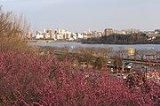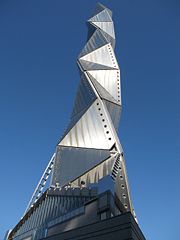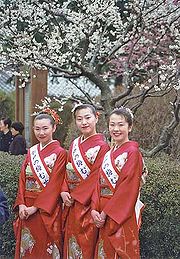
Mito, Ibaraki
Encyclopedia
is the capital of Ibaraki Prefecture
, Japan and has a central location, moderately offset towards the coast in that prefecture. As of 2005, the city has an estimated population
of 263,748 and a total area is 217.45 km², giving a population density
of 1,212.91 persons per km². Mito nattō
is the city's culinary specialty and is well-known across Japan.
Mito is the site of the Japanese garden
Kairaku-en
, located near Senba lake and counted as one of the Three Great Gardens of Japan
. Constructed by Tokugawa Nariaki
in 1842, the park is known nationwide for its ume
trees. Many people come to the park in spring to view the blossoms, particularly during the Ume Festival. In summer, Mito also holds the Mito Koumon
Festival.
Mito was the seat of the so-called Mito School
, a congregation of nativist scholars of Confucian
persuasion led by Aizawa Seishisai
, who during the 18th and 19th centuries advocated Western learning as a means not only to further Japanese technological development and international strength, but as means to prove Japanese uniqueness and superiority among nations.
, Baba Sukemoto, a warlord of the Heike family, moved to Mito and built a castle there. Mito Castle changed hands several times after that: a daimyo
named Satake Yoshinobu
won it in the mid-16th century, but he was forced to surrender it to Tokugawa Ieyasu
in 1603 after the epic Battle of Sekigahara
. Ieyasu's son Tokugawa Yorifusa
then took over Mito Castle, becoming one of the three "gosanke" family members fortified outside of Edo
. Edo was directly connected to Mito by the Mito Kaidō
. The Tokugawas directly ruled Mito until the mid-19th century, when the bakufu in Edo was overthrown.
The modern city of Mito was formed on April 1, 1889, with a population of 25,000. It was designated as the prefectural capital. By 1900, the Joban Line
connected it to Tokyo, and by 1910, telephones and electric lighting were available throughout the city. Although more than three-quarters of the city burned to the ground near the end of World War II
, the population rebounded to 70,000 just two years later, and has continued to grow ever since.
Today, Mito is primarily a commercial and administrative city: most industry in Ibaraki is concentrated around the nearby city of Tsukuba. Mito has a modest but thriving tourism
industry, centered on Kairaku-en (park) and local museums dedicated to the Tokugawa family. Mito is also the site of Ibaraki University
and Tokiwa University
.
(Mito Station
) and Joban Expressway
, which connects it to Tokyo
and Tsukuba
to the south and Hitachi
and Iwaki
to the north. The Suigun Line
runs north to Koriyama
, and the Mito Line
runs west to Oyama
. The closest major airport is Narita International Airport
. Ibaraki Airport in nearby Omitama
opened in March 2010. At present, it offers only limited service with one flight a day to Kobe, Korea (Seoul), and three flights a week to China (Shanghai). The airport hopes to attract services by budget air carriers and has structured services and fees accordingly.
.


Ibaraki Prefecture
is a prefecture of Japan, located in the Kantō region on the main island of Honshu. The capital is Mito.-History:Ibaraki Prefecture was previously known as Hitachi Province...
, Japan and has a central location, moderately offset towards the coast in that prefecture. As of 2005, the city has an estimated population
Population
A population is all the organisms that both belong to the same group or species and live in the same geographical area. The area that is used to define a sexual population is such that inter-breeding is possible between any pair within the area and more probable than cross-breeding with individuals...
of 263,748 and a total area is 217.45 km², giving a population density
Population density
Population density is a measurement of population per unit area or unit volume. It is frequently applied to living organisms, and particularly to humans...
of 1,212.91 persons per km². Mito nattō
Natto
is a traditional Japanese food made from soybeans fermented with Bacillus subtilis. It is popular especially as a breakfast food. As a rich source of protein and probiotics, nattō and the soybean paste miso formed a vital source of nutrition in feudal Japan. Nattō can be an acquired taste because...
is the city's culinary specialty and is well-known across Japan.
Mito is the site of the Japanese garden
Japanese garden
, that is, gardens in traditional Japanese style, can be found at private homes, in neighborhood or city parks, and at historical landmarks such as Buddhist temples, Shinto shrines and old castles....
Kairaku-en
Kairaku-en
is a Japanese garden located in Mito, Ibaraki, Japan. Along with Kenroku-en and Koraku-en, it is considered one of the Three Great Gardens of Japan. Kairakuen was built relatively recently in the year 1841 by the local lord Tokugawa Nariaki...
, located near Senba lake and counted as one of the Three Great Gardens of Japan
Three Great Gardens of Japan
The , also known as "the three most famous gardens in Japan" are considered to include Kenroku-en in Kanazawa, Koraku-en in Okayama and Kairaku-en in Mito....
. Constructed by Tokugawa Nariaki
Tokugawa Nariaki
Tokugawa Nariaki was a prominent Japanese daimyo who ruled the Mito domain and contributed to the rise of nationalism and the Meiji restoration.- Clan leader :...
in 1842, the park is known nationwide for its ume
Ume
Prunus mume, with the common names including Chinese plum and Japanese apricot, is an Asian tree species classified in the Armeniaca section of the genus Prunus. The flower, long a beloved subject in the traditional painting of East Asia, is usually translated as plum blossom. This distinct tree...
trees. Many people come to the park in spring to view the blossoms, particularly during the Ume Festival. In summer, Mito also holds the Mito Koumon
Tokugawa Mitsukuni
or was a prominent daimyo who was known for his influence in the politics of the early Edo period. He was the third son of Tokugawa Yorifusa and succeeded him, becoming the second daimyo of the Mito domain....
Festival.
Mito was the seat of the so-called Mito School
Mitogaku
Mitogaku refers to a school of Japanese historical and Shinto studies that arose in the Mito domain, in modern-day Ibaraki prefecture.The school had its genesis in 1657 when Tokugawa Mitsukuni , second head of the Mito domain, commissioned the compilation of the Dai Nihon-shi...
, a congregation of nativist scholars of Confucian
Confucianism
Confucianism is a Chinese ethical and philosophical system developed from the teachings of the Chinese philosopher Confucius . Confucianism originated as an "ethical-sociopolitical teaching" during the Spring and Autumn Period, but later developed metaphysical and cosmological elements in the Han...
persuasion led by Aizawa Seishisai
Aizawa Seishisai
, born ', was a Japanese nationalist thinker of the Mito school during the late shogunate period.In 1799 he became involved in the compilation of the Dai Nihon-shi being undertaken by the Mito school....
, who during the 18th and 19th centuries advocated Western learning as a means not only to further Japanese technological development and international strength, but as means to prove Japanese uniqueness and superiority among nations.
History
The Yamato people settled in Mito around the 4th century CE. Around the end of the Heian periodHeian period
The is the last division of classical Japanese history, running from 794 to 1185. The period is named after the capital city of Heian-kyō, or modern Kyōto. It is the period in Japanese history when Buddhism, Taoism and other Chinese influences were at their height...
, Baba Sukemoto, a warlord of the Heike family, moved to Mito and built a castle there. Mito Castle changed hands several times after that: a daimyo
Daimyo
is a generic term referring to the powerful territorial lords in pre-modern Japan who ruled most of the country from their vast, hereditary land holdings...
named Satake Yoshinobu
Satake Yoshinobu
was a Japanese daimyo of the Azuchi-Momoyama period through early Edo period. The eldest son of Satake Yoshishige, he was the first generation lord of the Kubota Domain...
won it in the mid-16th century, but he was forced to surrender it to Tokugawa Ieyasu
Tokugawa Ieyasu
was the founder and first shogun of the Tokugawa shogunate of Japan , which ruled from the Battle of Sekigahara in 1600 until the Meiji Restoration in 1868. Ieyasu seized power in 1600, received appointment as shogun in 1603, abdicated from office in 1605, but...
in 1603 after the epic Battle of Sekigahara
Battle of Sekigahara
The , popularly known as the , was a decisive battle on October 21, 1600 which cleared the path to the Shogunate for Tokugawa Ieyasu...
. Ieyasu's son Tokugawa Yorifusa
Tokugawa Yorifusa
, also known as Mito Yorifusa, was a Japanese daimyo of the early Edo period.- Biography :Known in his childhood as Tsuruchiyomaru, he was the eleventh son of Tokugawa Ieyasu, the first Tokugawa shogun...
then took over Mito Castle, becoming one of the three "gosanke" family members fortified outside of Edo
Edo
, also romanized as Yedo or Yeddo, is the former name of the Japanese capital Tokyo, and was the seat of power for the Tokugawa shogunate which ruled Japan from 1603 to 1868...
. Edo was directly connected to Mito by the Mito Kaidō
Mito Kaido
was an old kaidō in Japan and a subroute to the Edo Five Routes. It was built to connect Edo with Mito in modern-day Ibaraki Prefecture. Travelers from Edo called it Mito Kaidō, but travelers from Mito called it Edo Kaidō. The kaidō's path is traced by the modern National Route 6.-Tokyo:-Chiba...
. The Tokugawas directly ruled Mito until the mid-19th century, when the bakufu in Edo was overthrown.
The modern city of Mito was formed on April 1, 1889, with a population of 25,000. It was designated as the prefectural capital. By 1900, the Joban Line
Joban Line
The is a railway line in Japan operated by East Japan Railway Company . It begins at Nippori Station in Taitō, Tokyo and follows the Pacific coasts of Chiba, Ibaraki, and Fukushima Prefectures before the line officially ends at Iwanuma Station in Iwanuma, Miyagi...
connected it to Tokyo, and by 1910, telephones and electric lighting were available throughout the city. Although more than three-quarters of the city burned to the ground near the end of World War II
World War II
World War II, or the Second World War , was a global conflict lasting from 1939 to 1945, involving most of the world's nations—including all of the great powers—eventually forming two opposing military alliances: the Allies and the Axis...
, the population rebounded to 70,000 just two years later, and has continued to grow ever since.
Today, Mito is primarily a commercial and administrative city: most industry in Ibaraki is concentrated around the nearby city of Tsukuba. Mito has a modest but thriving tourism
Tourism
Tourism is travel for recreational, leisure or business purposes. The World Tourism Organization defines tourists as people "traveling to and staying in places outside their usual environment for not more than one consecutive year for leisure, business and other purposes".Tourism has become a...
industry, centered on Kairaku-en (park) and local museums dedicated to the Tokugawa family. Mito is also the site of Ibaraki University
Ibaraki University
, Japan, is a national university located in Ibaraki Prefecture, with campuses in the cities of Mito, Ami and Hitachi. It was established on May 31, 1949, integrating these prewar institutions: Mito High School , Ibaraki Normal School , Ibaraki Juvenile Normal School , and Taga Technical...
and Tokiwa University
Tokiwa University
is a private university in Mito, Ibaraki, Japan, established in 1983. The predecessor of the school was founded in 1909.California State University, Fresno & California State University, Northridge's Japanese Department has had an active international student exchange program with this university...
.
Transportation
Mito is located on the Joban LineJoban Line
The is a railway line in Japan operated by East Japan Railway Company . It begins at Nippori Station in Taitō, Tokyo and follows the Pacific coasts of Chiba, Ibaraki, and Fukushima Prefectures before the line officially ends at Iwanuma Station in Iwanuma, Miyagi...
(Mito Station
Mito Station (Ibaraki)
is a JR East and Kashima Rinkai Tetsudo railway station located in Mito, Ibaraki, Japan.-JR East:* Jōban Line* Suigun Line-Station layout:The station consists of four island platforms serving eight tracks.-History:...
) and Joban Expressway
Joban Expressway
The , abbreviated , is a national expressway in Japan. It is owned and operated by East Nippon Expressway Company.-Naming:Jōban is a kanji acronym consisting of two characters...
, which connects it to Tokyo
Tokyo
, ; officially , is one of the 47 prefectures of Japan. Tokyo is the capital of Japan, the center of the Greater Tokyo Area, and the largest metropolitan area of Japan. It is the seat of the Japanese government and the Imperial Palace, and the home of the Japanese Imperial Family...
and Tsukuba
Tsukuba, Ibaraki
is a city located in Ibaraki Prefecture, Japan. It is known as the location of the , a planned city developed in the 1960s.As of 2008, the city has an estimated population of 207,394 and a population density of 730 persons per km². Its total area is 284.07 km².Mount Tsukuba, particularly well-known...
to the south and Hitachi
Hitachi, Ibaraki
is a city located on the Pacific Ocean in Ibaraki Prefecture, Japan. Its name could be directly translated as "sunrise", but probably more appropriately adapted to "prosperous wealth" .-Demographics:...
and Iwaki
Iwaki, Fukushima
is a city located in the southern part of the Hamadōri coastal region of Fukushima Prefecture, Japan.A designated "core city", Iwaki is also one of the growing number of hiragana cities. Its area is 1,231.35 km², making it the 10th largest city in Japan...
to the north. The Suigun Line
Suigun Line
The is a Japanese railway line operated by East Japan Railway Company , which runs between Mito Station in Ibaraki Prefecture and Asaka-Nagamori Station in Fukushima Prefecture, Japan. All trains on the line continue onto the Tōhoku Main Line to Kōriyama Station...
runs north to Koriyama
Koriyama, Fukushima
is a city in the center of the Nakadōri region of Fukushima Prefecture, Japan. As of May 2011, the city had an estimated population of 336,328. The total area is 757 km²....
, and the Mito Line
Mito Line
The is a railway line between Oyama Station in Tochigi Prefecture and Tomobe Station in Ibaraki Prefecture, Japan. The line is long and is owned and operated by the East Japan Railway Company .- Station list :* All trains stop at every station....
runs west to Oyama
Oyama, Tochigi
is a city in Tochigi Prefecture, Japan.As April 1, 2011, the city has an estimated population of 163,954, with 62,714 households, and a population density of 955.39 persons per km²...
. The closest major airport is Narita International Airport
Narita International Airport
is an international airport serving the Greater Tokyo Area of Japan. It is located east of Tokyo Station and east-southeast of Narita Station in the city of Narita, and the adjacent town of Shibayama....
. Ibaraki Airport in nearby Omitama
Omitama, Ibaraki
is a city located in Ibaraki, Japan. The city was formed on March 27, 2006 from the merger of the towns of Ogawa and Minori, both from Higashiibaraki District, and the village of Tamari, from Niihari District...
opened in March 2010. At present, it offers only limited service with one flight a day to Kobe, Korea (Seoul), and three flights a week to China (Shanghai). The airport hopes to attract services by budget air carriers and has structured services and fees accordingly.
Professional sports
Mito is the home city of the J-League professional soccer team, Mito HollyHockMito HollyHock
is a Japanese professional football club, currently playing in the J. League Division 2. The team's hometown is located in Mito, Ibaraki Prefecture....
.
Famous residents
- Aizawa SeishisaiAizawa Seishisai, born ', was a Japanese nationalist thinker of the Mito school during the late shogunate period.In 1799 he became involved in the compilation of the Dai Nihon-shi being undertaken by the Mito school....
(1782–1863) - Stomu TakeishiStomu TakeishiStomu Takeishi is a Japanese jazz bass player. He generally plays fretless five-string electric bass guitar, as well as a Klein five-string acoustic bass guitar. He often uses looping or other electronic techniques to enhance the sound of his instrument.Takeishi began as a koto player...
(born 1964, jazz bass player)
Tourist attractions


- Kodokan School
- Mito Castle
- Lake Senba
- Kairakuen Park
- Ibaraki Museum of Modern Art
- Art Tower Mito
- Ibaraki Prefectural Museum of History
- Mito Municipal Botanical ParkMito Municipal Botanical ParkThe is a botanical garden located at 504 Kobuki, Mito, Ibaraki, Japan. It is open daily except Mondays; an admission fee is charged.The garden contains a terrace, rock garden, lawn, water features, and greenhouses heated from burning waste in the adjoining garbage disposal center.- References :* * *...
- The Tokugawa Museum

